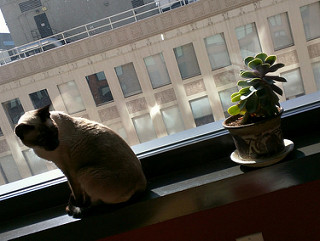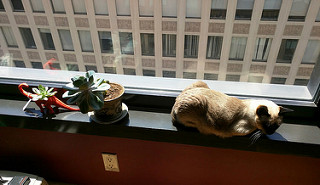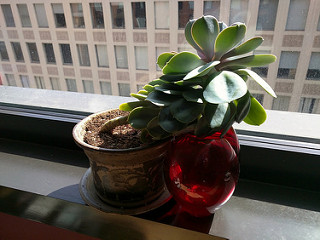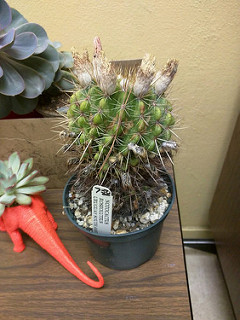In the fall of 2014 we attended a wedding for one of MJ’s cousins and guests got to bring home their own little succulent plant wedding favor. At the time we didn’t even know what a succulent was, but we dutifully carted it home on the flight.
For the first few months we kept it in the temporary container it came in and I didn’t have a lot of faith in my ability to keep it alive. We managed though, MJ did some research to learn what it was and how to move it into a pot, and it’s been growing ever since.
One day, Caligula wasn’t feeling well. After months of ignoring the plant, he decided that a plant was just the thing to sooth is upset stomach. He tried to bite it, but couldn’t find a good spot because the leaves have a spike at the end. We named the plant Spike.
In December of last year our dear Spike had a brush with fame! I snapped a picture of the rain one afternoon, and a glimpse of Spike was included in an article.
In April I attended an OpenStack Summit in Austin, Texas. At one of the parties Canonical was giving out succulents in dinosaur planters. How could I resist that? Plus, I’d continue the trend of free plants traveling home in carry on luggage. Having a succulent in a dinosaur planter sticking out of my purse was quite the conversation starter as I traveled home.
Spike has grown since it was that little wedding favor plant, and it never grew straight. Perhaps because we didn’t turn it enough and it grew towards the sun, or because succulents just keep growing and that just happens. We weren’t sure what to do though, as it eventually got to the point where it was too top-heavy to properly support its own weight! Spike now has scaffolding.
We’d grown quite fond of our little plant, and wanted to see how we could save him and not do the same with Dino. MJ did some research and found the Cactus & Succulent Society of San Jose that appeared to be very welcoming to folks like us looking for help and to identify what the plants are. We went last Sunday, upon my return from Maine and brought Spike and Dino along.
The society meets at a meetinghouse in a park in San Jose and the society members were just as welcoming as their website led us to believe! We were welcomed as we walked in and immediately had a few of our questions answered. As the presentation began they gave us chairs and raffle tickets for later in the meeting. The meeting had a presentation from a woman who sells a lot of succulents and also does a lot of craft projects that use the plants, putting them in living wreathes and various types of cages. I had worried that Dino living in a plastic dinosaur planter would offend them (what are you doing to your precious plant?!), but it turns out that putting succulents into interesting planters is quite a popular hobby. We learned that Dino is perfectly happy in that planter for now.

From the presentation, a succulent box that hangs on the wall, and some cages and various types of succulents
After the meeting they gave out awards for the mini-show that they had for members who brought in plants they wanted to share. We were able to get all the rest of our questions answered as well. We learned a bunch.
- Both Spike and Dino are of the Echeveria genus. We can do our own research online or at plant shows to compare ours to others to figure out exactly what kind of Echeveria they are. Spike has a purple tint to the leaves and dino has red.
- We didn’t actually destroy Spike, in spite of the lop-sidedness. Succulents grow and grow and grow. A method of reproduction is when a leaf drops off it can grow into another plant! Spike is ready to become lots of mini-Spikes!
- One of the reasons societies like this exist is so people can give away and sell their ever-growing population of succulents.
- We picked up some Miracle Grow soil for cacti and succulents at a home improvement store. That’s fine, but our plant likely doesn’t actually need fertilizer. Something to think about.
- We should be watering these succulents every week or two, but need to keep an eye on how moist the soil is since root rot is one of the only things that does kill these hearty plants.
- It’s pretty hard to kill a succulent, so they do use them for all kinds of craft projects and inventive ways.
They gave us some advice about how to handle Spike. They recommended cutting off the top(!), drying it out for a few weeks and replanting that. The bottom of the plant will also grow a new top of the plant. Assuming all goes well, we’ll at least end up with two Spikes that will hopefully grow straight this time, plus as many of the leaves as we want to grow into new plants. We have four leaves drying out now. We haven’t done the scary cutting and replanting yet, but it may be a project for this upcoming weekend, along with picking up a few more pots.
As the meeting wound down they did a raffle. The final ticket called was mine! We ended up going home with a Notocactus Roseoluteus, a flowering cactus. We certainly hadn’t planned on adding to our plant family at this meeting, but it’s a nice plant, and hopefully as a cactus it’ll be another plant that we can keep alive. Since we got this cactus in San Jose, we named it José.
So far José is doing ok, we watered it yesterday morning and it’s now sitting on the windowsill with the other plants.





